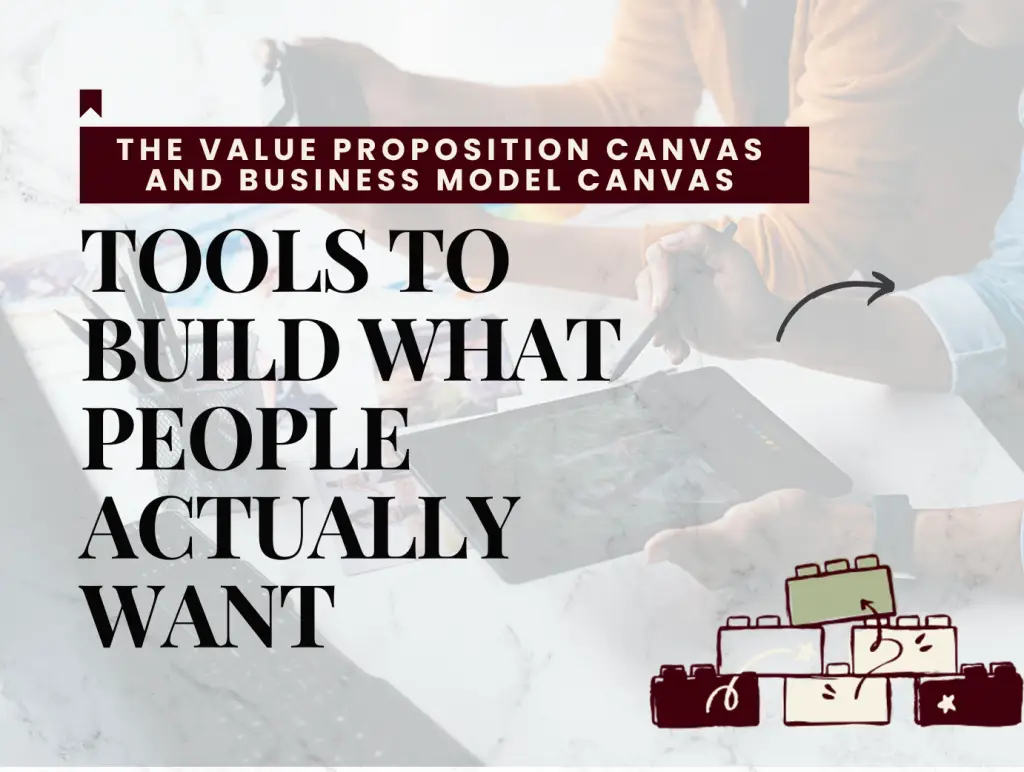Blog
The Value Proposition Canvas and Business Model Canvas: Tools to Build What People Actually Want

Summary
Building a great business starts with one crucial goal: creating something people actually want. This might sound obvious, but it’s surprisingly easy to lose focus on your customers and their needs. That’s where the Value Proposition Canvas, Business Model Canvas, and Personas come in. These tools help you stay grounded in your customers’ realities while crafting solutions they’ll love. Let’s break it down.
The Value Proposition Canvas: Solving Real Problems
The Value Proposition Canvas helps you design products and services that genuinely solve customer problems. It’s split into two parts:
Customer Profile:
Pains: What frustrates or challenges your customers? High costs? Inefficiency? Complexity?
Gains: What do they want to achieve? Save time? Reduce costs? Feel better?
Jobs: What are they trying to get done? This could be functional (finishing a task), emotional (feeling secure), or social (gaining approval).
Value Map:
Pain Relievers: How does your product fix what’s broken? Does it simplify, save time, or reduce risk?
Gain Creators: What new benefits does your solution offer? Maybe it’s faster, more reliable, or just better.
Products & Services: These are the specific things you offer to solve pains and create gains.
The magic happens when your Value Map aligns perfectly with your Customer Profile. That’s when you know you’re onto something people will love.
The Business Model Canvas: The Big Picture
The Business Model Canvas shows you how your idea fits into a sustainable business. It’s a simple way to think about your entire business model on one page. Here are its nine sections:
Customer Segments: Who are your customers?
Value Propositions: What’s the unique value you offer them?
Channels: How do you deliver your value?
Customer Relationships: How do you interact with customers?
Revenue Streams: How do you make money?
Key Resources: What do you need to deliver value?
Key Activities: What are the essential tasks?
Key Partnerships: Who helps you succeed?
Cost Structure: What are your main costs?
Using the Business Model Canvas ensures you’re not just solving problems but doing so in a way that can scale and sustain itself.
Personas: Bringing Customers to Life
Personas make your customers feel real. Instead of generic data, you get a detailed portrait of who you’re designing for. Here’s what to include:
Demographics: Age, gender, location, income.
Behavior Patterns: Buying habits, communication preferences.
Goals and Motivations: What do they care about?
Challenges and Pain Points: What gets in their way?
When you know your customers this well, it’s easier to design solutions that truly click with them.
Putting It All Together
Here’s how these tools work together to help you create products people want:
Start with Personas: Build a detailed understanding of your target customers.
Use the Value Proposition Canvas: Identify their pains, gains, and jobs, then map out how your solution fits.
Expand to the Business Model Canvas: Make sure your value proposition is part of a sustainable and scalable business model.
How to Make Sure Your Product Hits the Mark
Step 1: Talk to Real Customers
Rob Fitzpatrick’s The Mom Test teaches an essential lesson: « Talking to customers isn’t about asking them what they want. It’s about understanding their lives, pains, and goals. » Ask about their experiences and frustrations without pitching your idea too early.
Step 2: Build and Test Quickly
Eric Ries, author of The Lean Startup, says: « A startup is a human institution designed to create a new product or service under conditions of extreme uncertainty. » Test your assumptions fast with a Minimum Viable Product (MVP) and iterate based on feedback.
Step 3: Use Data to Validate
Alistair Croll and Benjamin Yoskovitz’s Lean Analytics emphasizes, « The only way to win is to learn faster than anyone else. » Track meaningful metrics, like customer engagement and retention, to see if your product solves the problem.
Real-World Examples
Slack: Solving Communication Overload
Persona: Professionals who feel overwhelmed by email.
Value Proposition Canvas:
Pains: Disorganized communication.
Gains: Simple, streamlined team messaging.
Jobs: Collaborate efficiently.
Business Model Canvas:
Customer Segments: Teams and businesses.
Revenue Streams: Freemium subscriptions.
Uber: Convenience at Your Fingertips
Persona: Urban dwellers needing quick rides.
Value Proposition Canvas:
Pains: Long waits and unreliable taxis.
Gains: Affordable, fast rides on demand.
Jobs: Travel across the city with ease.
Business Model Canvas:
Customer Segments: Riders and drivers.
Revenue Streams: Commissions per ride.
Dive Deeper with Actionable Steps
Integrate Feedback Loops
Each time you interact with customers, treat it as a learning opportunity. Implement a simple process: listen, adapt, and improve. Keep refining both your Value Proposition Canvas and Business Model Canvas as you gather insights.
Iterate Based on Real Data
Insights aren’t just about qualitative data from interviews. Dive into analytics to see what people are doing—and what they’re not. Tools like Google Analytics, Mixpanel, or customer heatmaps can show gaps you didn’t know existed.
Focus on Small Wins
Creating something people want doesn’t always mean grand gestures. Sometimes, a small pain reliever or an unexpected gain creator is enough to make a difference. Think of features that might simplify even a tiny part of your customers’ day.
Common Pitfalls and How to Avoid Them
Misunderstanding Customer Needs: Don’t assume—talk to customers. Fitzpatrick warns, « People will tell you what they think you want to hear. »
Rushing to Build: Focus on testing and learning, not just delivering features. Ries reminds us, « Success is solving the customer’s problem. »
Ignoring the Data: Use metrics that drive decisions, not just ones that look good. Croll and Yoskovitz call these « vanity metrics. »
Keep It Simple and Focused
The Value Proposition Canvas, Business Model Canvas, and Personas aren’t just tools; they’re your roadmap to building something people truly want. Stay focused on your customers, test your ideas, and adapt as you learn. With these tools, you’ll be well-equipped to create products that resonate and succeed.
Takeaways for Entrepreneurs
Stay Customer-Centric: Always come back to your customers. Their needs, pains, and goals are your guiding star.
Think Big, Start Small: Use the canvases to map out your vision, but focus on quick, actionable steps to validate your ideas.
Iterate Relentlessly: Building something people love is an ongoing process. Keep learning, adapting, and improving.
Armed with the Value Proposition Canvas, Business Model Canvas, and Personas, you’re ready to create products that people not only want but also rave about.

Hi, I’m Stacy, Fractional CMO
With over 10 years of experience, I help businesses in sectors like SaaS / Tech, e-commerce, healthcare, and B2B services.
Ready to Elevate Your Marketing Strategy?
Get the strategic expertise of a CMO without the full-time commitment.
As a Fractional CMO, I help ambitious businesses like yours scale faster, optimize resources, and achieve measurable growth. Whether you’re a startup, a growing company, or looking to break into new markets, I’ll craft a data-driven marketing strategy tailored to your unique goals.
Let’s transform your marketing together!



